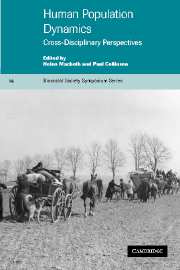Book contents
- Frontmatter
- Contents
- List of contributors
- Foreword by G.A. Harrison
- Preface
- 1 Introduction: the framework of studying human population dynamics
- 2 Demographic perspectives on human population dynamics
- 3 The growing concentration of world population from 1950 to 2050
- 4 Population, community and society in peasant societies
- 5 From genetic variation to population dynamics: insights into the biological understanding of humans
- 6 Social institutions and demographic regimes in non-industrial societies: a comparative approach
- 7 The dynamics of child survival
- 8 Genetic structure of south Indian caste populations: a confluence of biology and culture
- 9 Fertility, mortality and migration transitions in association with socioeconomic modernisation among highland minority populations in Southeast Asia
- 10 Ecology, homeostasis and survival in human population dynamics
- Glossary
- Index
- References
5 - From genetic variation to population dynamics: insights into the biological understanding of humans
Published online by Cambridge University Press: 11 August 2009
- Frontmatter
- Contents
- List of contributors
- Foreword by G.A. Harrison
- Preface
- 1 Introduction: the framework of studying human population dynamics
- 2 Demographic perspectives on human population dynamics
- 3 The growing concentration of world population from 1950 to 2050
- 4 Population, community and society in peasant societies
- 5 From genetic variation to population dynamics: insights into the biological understanding of humans
- 6 Social institutions and demographic regimes in non-industrial societies: a comparative approach
- 7 The dynamics of child survival
- 8 Genetic structure of south Indian caste populations: a confluence of biology and culture
- 9 Fertility, mortality and migration transitions in association with socioeconomic modernisation among highland minority populations in Southeast Asia
- 10 Ecology, homeostasis and survival in human population dynamics
- Glossary
- Index
- References
Summary
The extent of human biological variation
Humans are biological organisms. After chapters on demographic and socioeconomic perspectives on human populations and their spatial distribution, it is now appropriate to focus on contemporary ways in which world-wide human biological diversity and dynamics can be studied through human population genetics in its development in the era of the Human Genome Project.
The description of human differences is ancient. There are references in antiquity to humans with different physical features, such as those described by Herodotus, but the confusion between biological features and those we would today consider cultural was common until the twentieth century and still persists in some material. Over the course of the last century, there have been continuous debates about human diversity, but these debates were dominated by descriptions of morphological characteristics, for example pigmentation, and body shape and size. These descriptions in turn gave rise to ‘racial’ classifications, which remain highly significant socially. Even with the increase in understanding of genetic processes, much of this body of work has done nothing to further the understanding of human diversity, because in most cases the analyses did not take into consideration two basic issues.
The first issue is the evolutionary perspective on a given pattern of diversity. Following a tradition in the description of nature itself, the description of human populations continued to take, even recently, a naturalistic perspective, more in accordance with a pre-Darwinian view of detailed description than with its meaning in biological terms.
- Type
- Chapter
- Information
- Human Population DynamicsCross-Disciplinary Perspectives, pp. 83 - 102Publisher: Cambridge University PressPrint publication year: 2002



